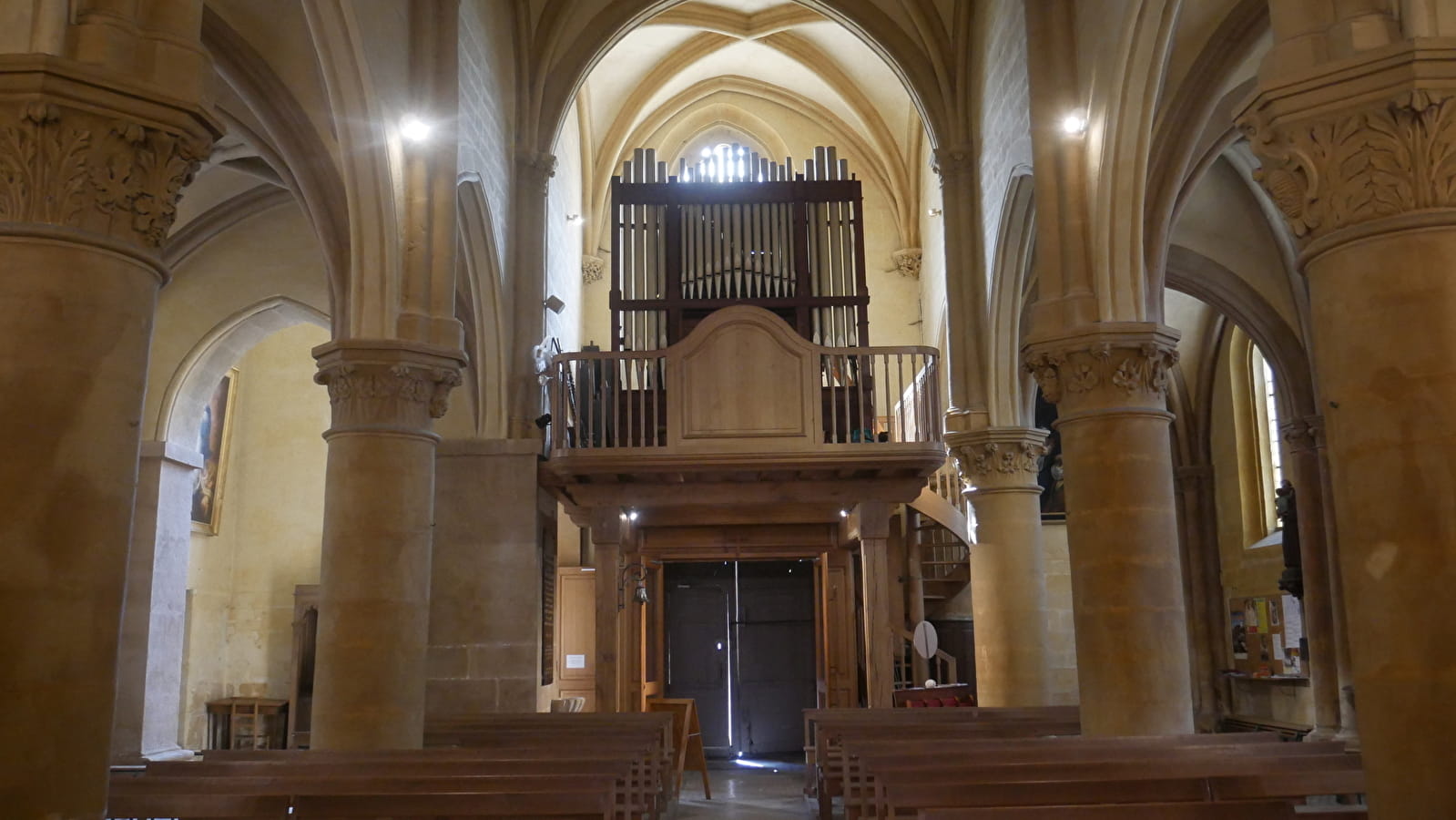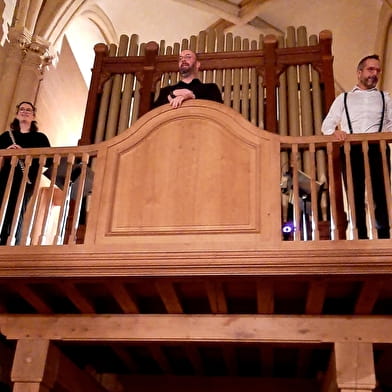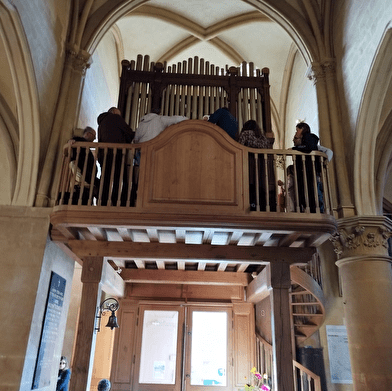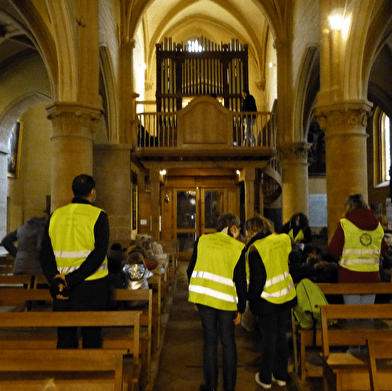
Orgue Banfield de l'église Saint-Léger
Banfield organ (1886) at Is-sur-Tille.
Church of Saint Léger.
The organ, which is not listed, differs from the usual techniques of the major French organ-building schools. The French organbuilder's curiosity, interest and appreciation of English organbuilding were evident when he discovered it.
Tenured organists, amateurs and Conservatoire organ teachers who have had the opportunity to discover it are delighted with both its range of sounds and its malleability, and enjoy a surprising, pleasant and easy-to-play instrument.
Special features
Among its many features, the radian (fan-shaped) pedalboard stands out for the contrast between its modest size and its many possibilities. What's more, in the course of initial reactions, people have said of it: "it's got a great sound", and "how beautiful the reed stop is! how beautiful this bass of ... is! It can also be soft, full of nuance and sensitivity.
Its sound relief is due to the judicious distribution of its 14 stops over two windchests and a pedal windchest split into two smaller ones.
A case in pitchwood for the front, oak on the C sharp side and softwood on the other side, houses a Great Organ and an Expressive Recital on two 56-note manuals with wooden action.
The 30-note radian pedalboard is made of oak with pneumatic transmission.
The stops are made of moulded oak with porcelain pastilles.
The strings are effective.
The clocks and front pipes are painted gold.
The Lauklouff engine is new.
Brief history
The restoration and reassembly of the organ were entrusted to Nicolas Martel, from Montmirey le Château in the Jura. The work was carried out using traditional organ-building techniques. Only the missing parts were rebuilt.
Inscriptions inside the organ tell us that it was built in 1886 by Banfield, restored in 1911 by Wooding and Bhain, rebuilt in 1948, and rebuilt by Longstaff and Jones in 1996; it was rebuilt in 2005, but there are no inscriptions to prove this.
It underwent a complete restoration (except for the pneumatic traction) at Is-sur-Tille between October 2018 and July 2019. The new bellows and the renovation of the windchests had been carried out beforehand.
In July 2019, the organ will be handed over to Sylvain Pluyaut, organist and organ and music teacher at the Conservatoire de Région Bourgogne-Franche-Comté.
In September 2019, it will be inaugurated by Thierry DARPHIN, the mayor, and blessed the same morning by Albert Zoungrana, the parish priest.
On the afternoon of the same day, the inauguration concert was performed by Sylvain Pluyaut, the association's musical referent.
Composition of the organ
Great organ: (with super octave system)
- Open diapason 8, Dulciane 8, Stop diap+charabella 8
- Principal 4, Flute 4, Twelth 2 2/3, Fifteen 2.
Expressive narrative:
- Horn diapason 8, Salicional 8, Lieblied Gedach 8
- Gemshorn 4, Fifteen 8, Corpean 8, Trémolo
Pedalboard:
- Bourdon 16, Flûte bass 4
- Tirasse GO and Récit
- Recit/GO coupling
Couplings:
- Coupling II/I
- High octave II/I coupling
- Tirasse I/pedal
- Bridge II/pedal
The corresponding mechanism is located above the keyboards, which are operated by manual stop pulls.
The instrument is maintained by Mr Nicolas Martel. The heating is forced-air. The blower is located opposite the organ loft. The organ's Lauklouff fan is new.
The three organists are :
- André Boillot (90).
- Jean-Roland Rousseaux (40 years old).
- Antoine Sabatier (18 years old).
The owner is currently the Association des Amis de l'Orgue.
The purpose of the association "Les Amis de l'Orgue à Is-sur-Tille", which was formalised in 2021, is to bring the instrument to life and maintain it. It is a continuation of the AOIS, "Association pour un orgue à Is" (Association for an organ in Is-sur-Tille) declared in 1997, whose aim was to acquire a pipe organ.
Our activities
I/ Organ and worship
The organ is heard throughout the year at religious services.
It also accompanies special events such as masses led by religious authorities and bishops visiting the parish.
It played at the mass for Sainte Geneviève, patron saint of the Gendarmes in 2019.
.2/ Organ, tourism and heritage
The association regularly takes part in
-Heritage days. September 2019, 2022, 2023.
-Small Heritage Days weekends in June 2023.
With :
* Explanatory tour of the history of the Bandfield organ.
* Detailed description of its construction.
* Then, in the gallery, explanations of how the instrument works, based on its particular features.
* Finally, the main stage: discovery of the console with explanations and demonstrations of the stops, pedals, pulls, keyboards, the different sounds of the instrument, and finally listening to works by different composers.
* At the entrance to the church, a guided exhibition on the theme of "What is an organ?" with A4 photos of the interior of the Banfield organ.
This year (2023), "organ tourist Mondays" will be introduced, with appropriate content, during July and August, by prior arrangement. Length of visit: 1 hour.
3/ Organ and school events
From March, i.e. after the heating has been turned off, an organist will be available every Monday to help children discover the instrument and its sounds, with explanations and commentaries tailored to questions from nursery and primary school children.
5/ Cultural events
Organisation of one concert per year:
* September 2019: inaugural concert with: organ and choir, organ and flute, saxophone.
* After covid in 2022: "organ and two flutes" concert.
* 02 September 2023: Join us at the FORUM des ASSOCIATIONS at the esplanade des capucins in IS sur TILLE.
- English
- Pets not allowed
- Parking
- Specific theme activities
Visits on Mondays during the summer holidays by appointment. Occasional visits the rest of the year.
Brochures Bourgogne Tourisme
Consult our brochures online or order them to receive at home






